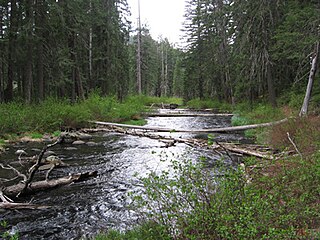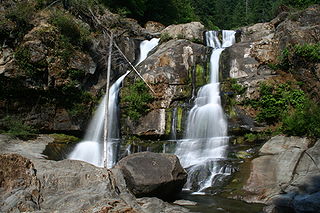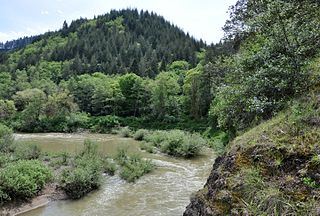| North Fork John Day River | |
|---|---|
 The river flowing beside Highway 395 in Umatilla County | |
| Etymology | John Day, fur trapper |
| Location | |
| Country | United States |
| State | Oregon |
| County | Grant County, Umatilla County |
| Physical characteristics | |
| Source | |
| - location | Blue Mountains near Mount Ireland, Grant County, Oregon |
| - coordinates | 44°51′48″N118°14′13″W / 44.86333°N 118.23694°W [1] |
| - elevation | 7,466 ft (2,276 m) [2] |
| Mouth | John Day River |
| - location | Kimberly, Grant County, Oregon |
| - coordinates | 44°45′22″N119°38′19″W / 44.75611°N 119.63861°W Coordinates: 44°45′22″N119°38′19″W / 44.75611°N 119.63861°W [1] |
| - elevation | 1,834 ft (559 m) [1] |
| Length | 107 mi (172 km) [3] [4] |
| Discharge | |
| - location | Monument, Oregon, 15.3 miles (24.6 km) from mouth [5] |
| - minimum | 6 cu ft/s (0.17 m3/s) |
| - average | 1,297 cu ft/s (36.7 m3/s) [5] |
| - maximum | 33,400 cu ft/s (950 m3/s) |
| Basin features | |
| Basin size | 1,800 sq mi (4,700 km2) [6] |
| Type | Wild, Scenic, Recreational |
| Designated | October 28, 1988 |
The North Fork John Day River is a 107-mile (172 km) tributary of the John Day River in the U.S. state of Oregon. It begins in Grant County about 20 miles (32 km) northwest of Baker City near the crest of the Blue Mountains. It flows generally west to the community of Dale on U.S. Route 395, then southwest through the city of Monument to the unincorporated community of Kimberly, where it meets the main stem of the John Day River.

The John Day River is a tributary of the Columbia River, approximately 284 miles (457 km) long, in northeastern Oregon in the United States. Undammed along its entire length, the river is the third longest free-flowing river in the contiguous United States. There is extensive use of its waters for irrigation. Its course furnishes habitat for diverse species, including wild steelhead and Chinook salmon runs. However, the steelhead populations are under federal Endangered Species Act (ESA) protections, and the Chinook salmon have been proposed for such protection.

Oregon is a state in the Pacific Northwest region on the West Coast of the United States. The Columbia River delineates much of Oregon's northern boundary with Washington, while the Snake River delineates much of its eastern boundary with Idaho. The parallel 42° north delineates the southern boundary with California and Nevada. Oregon is one of only three states of the contiguous United States to have a coastline on the Pacific Ocean.

Grant County is a county located in the U.S. state of Oregon. As of the 2010 census, the population was 7,445. The county seat is Canyon City. It is named for President Ulysses S. Grant, who served as an army officer in the Oregon Territory, and at the time of the county's creation was a Union general in the American Civil War.
Contents
The upper reaches of the river flow through the North Fork John Day Wilderness in the Wallowa–Whitman National Forest and the Umatilla National Forest. From its headwaters to its confluence with Camas Creek, the river is part of the National Wild and Scenic River system. The upper 27.8 miles (44.7 km) is classified wild, the next 10.5 miles (16.9 km) scenic, and the next 15.8 miles (25.4 km) recreational, for a total of 54.1 miles (87.1 km). [7]

The North Fork John Day Wilderness is a wilderness area within the Umatilla and Wallowa–Whitman National Forests in the Blue Mountains of northeastern Oregon.

The Wallowa–Whitman National Forest is a United States National Forest in the U.S. states of Oregon and Idaho. Formed upon the merger of the Wallowa and Whitman national forests in 1954, it is located in the northeastern corner of the state, in Wallowa, Baker, Union, Grant, and Umatilla counties in Oregon, and includes small areas in Nez Perce and Idaho counties in Idaho. The forest is named for the Wallowa band of the Nez Perce people, who originally lived in the area, and Marcus and Narcissa Whitman, Presbyterian missionaries who settled just to the north in 1836. Forest headquarters are located in Baker City, Oregon with ranger districts in La Grande, Joseph and Baker City.

The Umatilla National Forest, in the Blue Mountains of northeast Oregon and southeast Washington, covers an area of 1.4 million acres (5,700 km2). In descending order of land area the forest is located in parts of Umatilla, Grant, Columbia, Morrow, Wallowa, Union, Garfield, Asotin, Wheeler, and Walla Walla counties. More than three-quarters of the forest lies in the state of Oregon. Forest headquarters are located in Pendleton, Oregon. There are local ranger district offices in Heppner and Ukiah in Oregon, and in Pomeroy and Walla Walla in Washington.
The North Fork John Day River is one of the most important in northeast Oregon for anadromous fish. Wildlife found near the river includes mule deer, elk, and black bears, peregrine falcons, and bald eagles. Recreational uses include hunting, fishing, horseback riding, hiking, snowmobiling, skiing, camping, and whitewater rafting. [7]

Many types of fish migrate on a regular basis, on time scales ranging from daily to annually or longer, and over distances ranging from a few metres to thousands of kilometres. Fish usually migrate to feed or to reproduce, but in other cases the reasons are unclear.

The mule deer is a deer indigenous to western North America; it is named for its ears, which are large like those of the mule. The several subspecies include the black-tailed deer.

The elk or wapiti is one of the largest species within the deer family, Cervidae, and one of the largest terrestrial mammals in North America and Northeast Asia. This animal should not be confused with the still larger moose to which the name "elk" applies in British English and in reference to populations in Eurasia.














